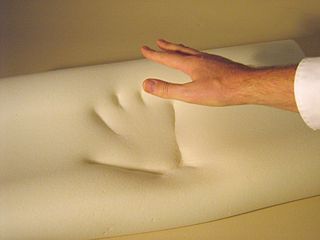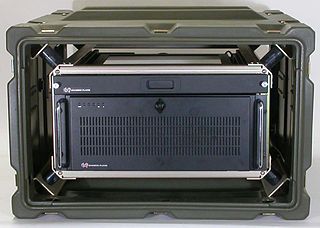Related Research Articles

A shock absorber or damper is a mechanical or hydraulic device designed to absorb and damp shock impulses. It does this by converting the kinetic energy of the shock into another form of energy which is then dissipated. Most shock absorbers are a form of dashpot.

Foams are materials formed by trapping pockets of gas in a liquid or solid.

Soundproofing is any means of impeding sound propagation. There are several basic ways to reduce sound: increasing the distance between source and receiver, decoupling, using noise barriers to reflect or absorb the energy of the sound waves, using damping structures such as sound baffles for absorption, or using active antinoise sound generators.
In materials science and continuum mechanics, viscoelasticity is the property of materials that exhibit both viscous and elastic characteristics when undergoing deformation. Viscous materials, like water, resist shear flow and strain linearly with time when a stress is applied. Elastic materials strain when stretched and immediately return to their original state once the stress is removed.
In the field of acoustics, a diaphragm is a transducer intended to inter-convert mechanical vibrations to sounds, or vice versa. It is commonly constructed of a thin membrane or sheet of various materials, suspended at its edges. The varying air pressure of sound waves imparts mechanical vibrations to the diaphragm which can then be converted to some other type of signal; examples of this type of diaphragm are found in microphones and the human eardrum. Conversely a diaphragm vibrated by a source of energy beats against the air, creating sound waves. Examples of this type of diaphragm are loudspeaker cones and earphone diaphragms and are found in air horns.
A quartz crystal microbalance (QCM) measures a mass variation per unit area by measuring the change in frequency of a quartz crystal resonator. The resonance is disturbed by the addition or removal of a small mass due to oxide growth/decay or film deposition at the surface of the acoustic resonator. The QCM can be used under vacuum, in gas phase and more recently in liquid environments. It is useful for monitoring the rate of deposition in thin-film deposition systems under vacuum. In liquid, it is highly effective at determining the affinity of molecules to surfaces functionalized with recognition sites. Larger entities such as viruses or polymers are investigated as well. QCM has also been used to investigate interactions between biomolecules. Frequency measurements are easily made to high precision ; hence, it is easy to measure mass densities down to a level of below 1 μg/cm2. In addition to measuring the frequency, the dissipation factor is often measured to help analysis. The dissipation factor is the inverse quality factor of the resonance, Q−1 = w/fr ; it quantifies the damping in the system and is related to the sample's viscoelastic properties.

Memory foam consists mainly of polyurethane with additional chemicals that increase its viscosity and density. It is often referred to as "viscoelastic" polyurethane foam, or low-resilience polyurethane foam (LRPu). The foam bubbles or ‘cells’ are open, effectively creating a matrix through which air can move. Higher-density memory foam softens in reaction to body heat, allowing it to mold to a warm body in a few minutes. Newer foams may recover their original shape more quickly.

Ethylene-vinyl acetate (EVA), also known as poly(ethylene-vinyl acetate) (PEVA), is a copolymer of ethylene and vinyl acetate. The weight percent of vinyl acetate usually varies from 10 to 90%, with the remainder being ethylene. There are three different types of EVA copolymer, which differ in the vinyl acetate (VA) content and the way the materials are used.
A football helmet is a type of protective headgear used mainly in gridiron football, although a structural variation has occasional use in Australian rules football. It consists of a hard plastic shell with thick padding on the inside, a face mask made of one or more plastic-coated metal bars, and a chinstrap. Each position has a different type of face mask to balance protection and visibility, and some players add polycarbonate visors to their helmets, which are used to protect their eyes from glare and impacts. Helmets are a requirement at all levels of organized football, except for non-tackle variations such as flag football. Although they are protective, players can and do still suffer head injuries such as concussions.

Foam rubber refers to rubber that has been manufactured with a foaming agent to create an air-filled matrix structure. Commercial foam rubbers are generally made of synthetic rubber, natural latex or polyurethane. Latex foam rubber, used in mattresses, is well known for its endurance. Polyurethane is a thermosetting polymer that comes from combination of Methyl di-isocyanate and polyethylene and some other chemical additives.
Dynamic modulus is the ratio of stress to strain under vibratory conditions. It is a property of viscoelastic materials.
Vibration isolation is the prevention of transmission of vibration from one component of a system to others parts of the same system, as in buildings or mechanical systems. Vibration is undesirable in many domains, primarily engineered systems and habitable spaces, and methods have been developed to prevent the transfer of vibration to such systems. Vibrations propagate via mechanical waves and certain mechanical linkages conduct vibrations more efficiently than others. Passive vibration isolation makes use of materials and mechanical linkages that absorb and damp these mechanical waves. Active vibration isolation involves sensors and actuators that produce disruptive interference that cancels-out incoming vibration.

A shock mount or isolation mount is a mechanical fastener that connects two parts elastically. They are used for shock and vibration isolation.
A blowing agent is a substance which is capable of producing a cellular structure via a foaming process in a variety of materials that undergo hardening or phase transition, such as polymers, plastics, and metals. They are typically applied when the blown material is in a liquid stage. The cellular structure in a matrix reduces density, increasing thermal and acoustic insulation, while increasing relative stiffness of the original polymer.

Package cushioning is used to protect items during shipment. Vibration and impact shock during shipment and loading/unloading are controlled by cushioning to reduce the chance of product damage.
Polymer engineering is generally an engineering field that designs, analyses, and modifies polymer materials. Polymer engineering covers aspects of the petrochemical industry, polymerization, structure and characterization of polymers, properties of polymers, compounding and processing of polymers and description of major polymers, structure property relations and applications.
Acoustic quieting is the process of making machinery quieter by damping vibrations to prevent them from reaching the observer. Machinery vibrates, causing sound waves in air, hydroacoustic waves in water, and mechanical stresses in solid matter. Quieting is achieved by absorbing the vibrational energy or minimizing the source of the vibration. It may also be redirected away from the observer.

A mattress pad, mattress topper, or underpad is designed to lie atop a mattress. Made from a variety of materials such as wool, cotton, memory foam, feather or latex, its function is to provide an extra layer of comfort, especially when the existing mattress is worn or uncomfortable.
Microrheology is a technique used to measure the rheological properties of a medium, such as microviscosity, via the measurement of the trajectory of a flow tracer. It is a new way of doing rheology, traditionally done using a rheometer. There are two types of microrheology: passive microrheology and active microrheology. Passive microrheology uses inherent thermal energy to move the tracers, whereas active microrheology uses externally applied forces, such as from a magnetic field or an optical tweezer, to do so. Microrheology can be further differentiated into 1- and 2-particle methods.
Materials that are used for biomedical or clinical applications are known as biomaterials. The following article deals with fifth generation biomaterials that are used for bone structure replacement. For any material to be classified for biomedical applications, three requirements must be met. The first requirement is that the material must be biocompatible; it means that the organism should not treat it as a foreign object. Secondly, the material should be biodegradable ; the material should harmlessly degrade or dissolve in the body of the organism to allow it to resume natural functioning. Thirdly, the material should be mechanically sound; for the replacement of load-bearing structures, the material should possess equivalent or greater mechanical stability to ensure high reliability of the graft.
References
- ↑ U.S. Patent 4346205A
- 1 2 "Inventor fleshes out plan for better boots". New Scientist. Reed Business Information. 6 December 1979. p. 778. ISSN 0262-4079 . Retrieved 28 June 2012.
- ↑ Smock, Doug (13 August 2009). "Unique Urethane Dampens Shocks and Noise". designnews.com. Archived from the original on 3 September 2009.
- ↑ Cinats, J; Reid, DC; Haddow, JB (1987). "A biomechanical evaluation of sorbothane". Clin Orthop Relat Res (222): 281–8. PMID 3621732.
- ↑ Houston, Janice; Gattis, Christy (5 January 2004). Passive Isolators for Use on the International Space Station (PDF). 42nd AIAA Aerospace Sciences Meeting and Exhibit. Reston, Virigina: American Institute of Aeronautics and Astronautics. doi:10.2514/6.2004-787.
- ↑ "Sorbothane Protects NASA Components During Launch". Sorbothane Insoles. 14 May 2019. Retrieved 27 October 2022.
- ↑ "Designing the Perfect Memorial: Sorbothane & the Air Force Memorial - www.sorbothane.com". www.sorbothane.com. 23 July 2019. Retrieved 27 October 2022.
- ↑ "Vibration Solutions - www.sorbothane.com". www.sorbothane.com. 3 February 2015. Retrieved 27 October 2022.
- ↑ James Russell (1 January 1998). Precision Shooting: The Trapshooter's Bible : for the Advanced Trapshooter & Those who Strive to be ... James Russell Publishing. p. 107. ISBN 978-0-916367-10-7 . Retrieved 28 June 2012.